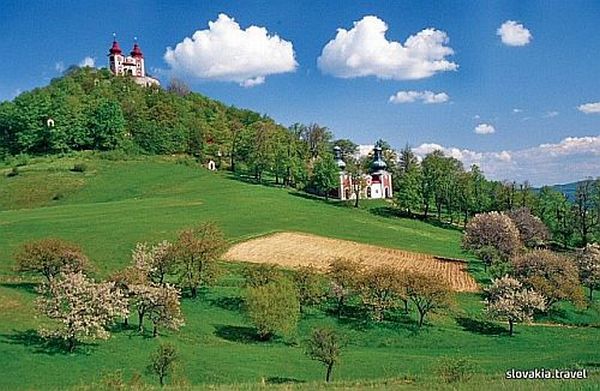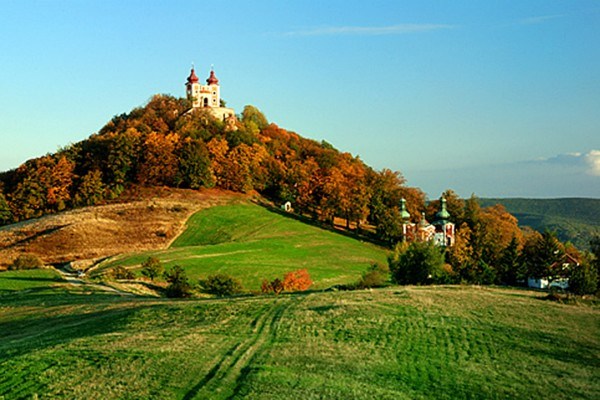Banska Stiavnica Kalvaria / Calvary

SK: Skrysa sa nachadza asi v strede Kalvarie. Pozri hint.
ENG: The cache is located approximately in the middle of Calvary . See hint.


SK:
Banskoštiavnická Kalvária predstavuje rozsahom i obsahom unikátny architektonicko-krajinný celok. Je najvýznamnejšou barokovou kalváriou na Slovensku. Kalvária je komplexom 25-tich kaplniek, z toho troch kostolov s vzácnou malovanou výzdobou. Obsahuje drevený a kovácsky mobiliár a drevené malované reliéfy. Objekty kaplniek a kostolov sú „zasadené“ do svahu utuhnutého lávového stlpa uprostred vyhasnutej sopky – kopca Scharffenberg (Ostrý vrch).
Jej základný kamen bol položený v roku 1744 za spolupráce katolíkov aj evanjelikov. Práce viedol tvorca myšlienky stavby – jezuita páter František Perger, pravdepodobne na základe architektonického návrhu významného polyhistora, kartografa a stavitela – Samuela Mikovíniho.
Banskoštiavnická Kalvária je
- najimpozantnejšou barokovou kalváriou v strednej Európe
- jednou z najstarších kalvárií na Slovensku
- výtvarne najexkluzívnejšou barokovou stavbou svojho druhu
- od roku 1993 je súcastou územia, ktoré spolu s historickým mestom Banská Štiavnica boli zaradené na Zoznam svetového kultúrneho a prírodného dedicstva UNESCO
- od júna 2007 do konca roku 2009 bola na zozname 100 najohrozenejších pamiatok sveta, ktorý vyhlasuje World Monument Fund v New Yorku www.worldmonumentswatch.org
Kalvária a okolie
Kalvária leží na východnom okraji mesta Banská Štiavnica (vzdialenost od centra 2 km), ktorého pociatky súvisia s výskytom striebra a zlata. Tieto rudy dobývali už Kelti v 3.-2. stor. pred Kr. Okrem unikátneho historického jadra, možno v meste navštívit 6 expozícií Slovenského banského múzea (banská technika, podzemný i nadzemný skanzen, mineralógia, história na Starom zámku, Nový zámok s výhladom na mesto, galéria). O Banskej Štiavnici sa dozviete viac na www.banskastiavnica.sk a www.banskastiavnica.org.
http://www.kalvaria.org/sk/

ENG:
Banská Štiavnica Calvary Complex – the most beautiful and indeed most important Baroque monument in Slovakia
Banská Štiavnica Calvary Complex represents a unique architectural and landscape complex as regards both its extent and content. It truly is the most outstanding Baroque Calvary complex in the territory of the Slovak Republic. The complex itself consists of 25 buildings including three churches and chapels decorated with invaluable paintings. There also are wood and ironwork furnishings and painted wooden reliefs. The chapels and churches are built on a steep slope of a dormant volcano called Scharffenberg (Sharp Hill).
The Calvary’s foundation stone was laid in 1744 under cooperation of both the Catholics and the Protestants. The work was conducted by the creator of the whole construction idea, a Jesuit priest František Perger, most probably based on an architectural rendering elaborated by a well renowned polyhistor, cartographer and constructor Samuel Mikovíni.
Banská Štiavnica Calvary Complex is:
the most imposing Baroque Calvary Complex in Central Europe
one of the oldest Calvary complexes in Slovakia
artistically most exclusive Baroque construction of its kind
since 1993 part of the territory (including the historical town of Banská Štiavnica) included in UNESCO World Heritage List
since June 2007 until the end of 2009 was on included in the World Monuments List of 100 most endangered sites announced by the World Monument Fund in New York www.worldmonumentswatch.org
Since the times in which the Calvary Complex was being utilised regularly (1751) until the year 1951 the area including the buildings was maintained by the Calvary Fund. The construction of the churches and chapels as well as their rich decoration were financed inter alia by the Roman Emperor Franz I., the mining society Michalštôlna, Count Koháry, an Italian merchant Markini, burgher Krecsmáry and other personalities of those days.
At present, single Calvary churches and chapels are in critical technical condition. Endangered are also the invaluable interior paintings, the remaining wooden furnishings, the wooden and stone reliefs as well as other details.
In 2007 an initiative was formed consisting of professionals in the field and the site owners that started working systematically on its preservation and have elaborated a complex project of its preservation and future utilisation.
http://www.kalvaria.org/en/







